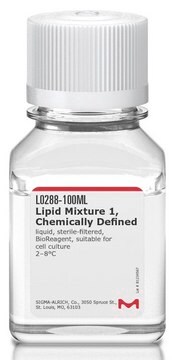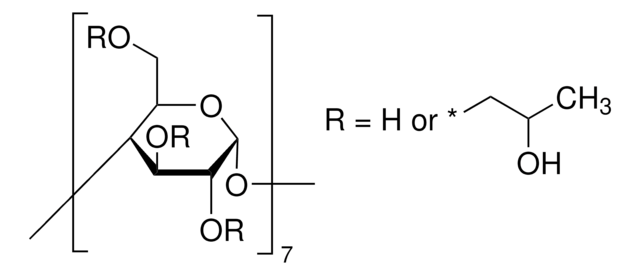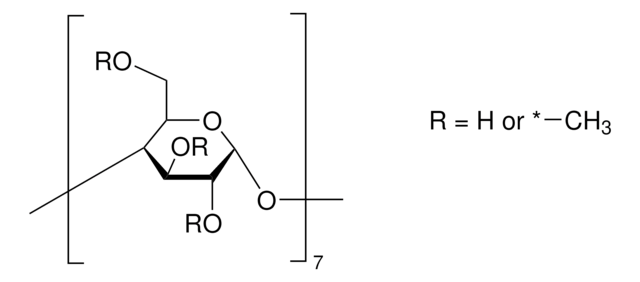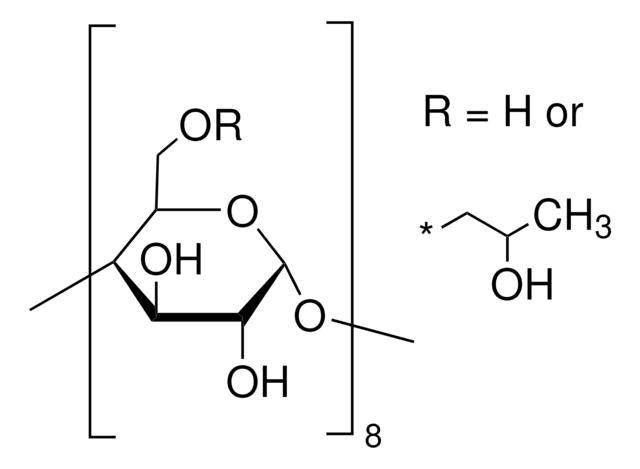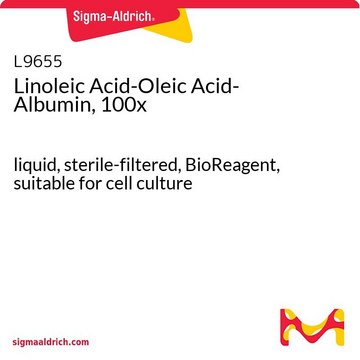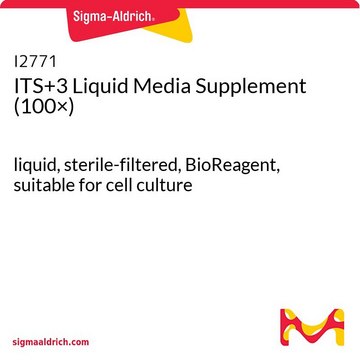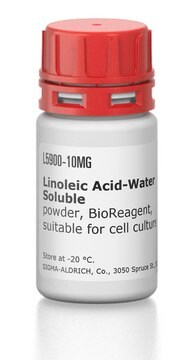L5146
Lipid Mixture (1000×)
liquid, sterile-filtered, BioReagent, suitable for insect cell culture
Synonym(s):
Lipid Mixture for cell culture
Sign Into View Organizational & Contract Pricing
All Photos(1)
About This Item
UNSPSC Code:
12352211
NACRES:
NA.75
Recommended Products
sterility
sterile-filtered
Quality Level
product line
BioReagent
form
liquid
composition
cholesterol, 4.5 g/L
cod liver oil fatty acids (methyl esters), 10 g/L
polyoxyethylenesorbitan monooleate, 25 g/L
D-α-tocopherol acetate, 2.0 g/L
technique(s)
cell culture | insect: suitable
storage temp.
2-8°C
Application
Lipid Mixture (1000×) is used as a component in culture medium (of Perkinsus marinus strain). It is also used in Perkinsus marinus metabolite labeling and analysis.
Biochem/physiol Actions
The density of a lipid mixture is composed of nearly 85% wax esters. The wax ester mixture melts as a function of temperature at atmospheric pressure. No significant indications of non-random long-range lateral lipid distribution are seen in the all-fluid and all-gel state of the lipid mixture at ambient pressure. The morphology of the concentration fluctuations that is observed within the two-phase coexistence region of the lipid mixture can be characterized as a complex heterogeneous network of coexisting clusters with fractal-like properties.
related product
Product No.
Description
Pricing
Signal Word
Danger
Hazard Statements
Precautionary Statements
Hazard Classifications
Eye Irrit. 2 - Flam. Liq. 2
Storage Class Code
3 - Flammable liquids
WGK
WGK 2
Flash Point(F)
57.2 °F - closed cup
Flash Point(C)
14.0 °C - closed cup
Choose from one of the most recent versions:
Already Own This Product?
Find documentation for the products that you have recently purchased in the Document Library.
Customers Also Viewed
A Pestronk et al.
Neurology, 48(4), 1104-1106 (1997-04-01)
IgM anti-GM1 antibodies are associated with motor neuropathy syndromes, including multifocal motor neuropathy (MMN). We compared the ability of serum IgM from patients with multifocal motor neuropathy to bind to GM1 ganglioside alone and to GM1 as a component of
Jillian C Danne et al.
Molecular biology and evolution, 30(1), 123-139 (2012-08-28)
Mitochondrial metabolism is central to the supply of ATP and numerous essential metabolites in most eukaryotic cells. Across eukaryotic diversity, however, there is evidence of much adaptation of the function of this organelle according to specific metabolic requirements and/or demands
Motomichi Matsuzaki et al.
Molecular biology and evolution, 25(6), 1167-1179 (2008-03-25)
Plastids are widespread in plant and algal lineages. They are also exploited by some nonphotosynthetic protists, including malarial parasites, to support their diverse modes of life. However, cryptic plastids may exist in other nonphotosynthetic protists, which could be important in
Isao Masuda et al.
Nucleic acids research, 38(18), 6186-6194 (2010-05-29)
Diverse mitochondrial (mt) genetic systems have evolved independently of the more uniform nuclear system and often employ modified genetic codes. The organization and genetic system of dinoflagellate mt genomes are particularly unusual and remain an evolutionary enigma. We determined the
Esmail Lutfi et al.
Aquatic toxicology (Amsterdam, Netherlands), 188, 148-158 (2017-05-21)
Numerous environmental pollutants have been identified as potential obesogenic compounds affecting endocrine signaling and lipid homeostasis. Among them, well-known organotins such as tributyltin (TBT) and triphenyltin (TPT), can be found in significant concentrations in aquatic environments. The aim of the
Our team of scientists has experience in all areas of research including Life Science, Material Science, Chemical Synthesis, Chromatography, Analytical and many others.
Contact Technical Service